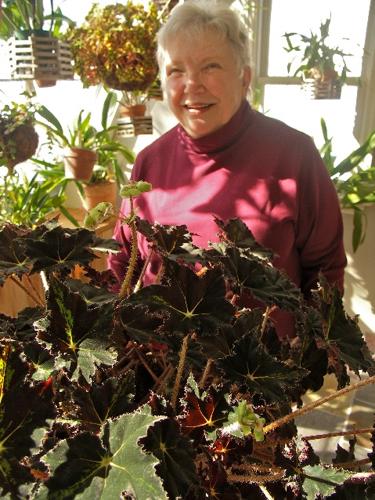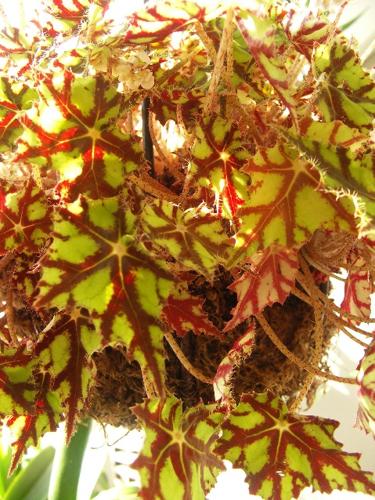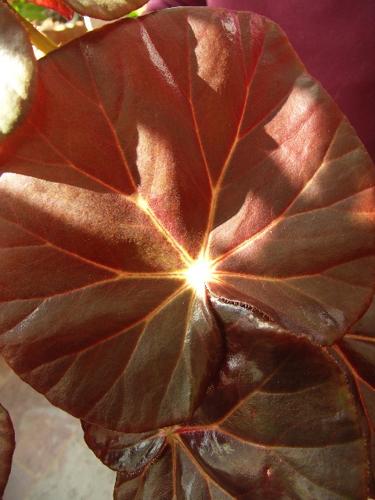In the overwhelming visual cacophony that is the Philadelphia International Flower Show, with displays that suspend disbelief in a combination Cirque du Soleil/Mummers Parade riot of color and structure, the common houseplant tends to get a little lost.
But for Denise Conklin of Lancaster, the chance to vie against international competitors in this grandmommy of all flower shows offers plenty of drama, no matter how understated it may seem.
Conklin, who will turn 70 this year, has been nurturing a family begonia for nearly half a century. This particular begonia was handed down by her German grandmother, Bertha Lindenlauf, to her mother in 1918. It then came to her on her wedding day in 1965.
"When my mother got married, my grandmother gave her this plant and said 'as long as you keep this alive, your marriage will last,' " Conklin related. "Talk about pressure, especially if you didn't have a green thumb."
Begonias are easily propagated, and Conklin has given pieces to her whole extended family.
However, she has had a few scares, nearly killing hers several times, most recently two years ago. But she's brought it back, ensuring it developed a well-rounded form in time to compete in this year's show.
This heirloom cultivar is so old, it didn't have a name to register for the show, so Conklin was given the opportunity to honor her grandmother by naming it "Lady L." Now Conklin's hoping it will honor her grandmother by bringing home a blue ribbon from the show.
"The competition there is so awesome, it's the best in the world," she said.
In the late 1800s, begonias became the fashionable must-have home accessory of the well-to-do Victorians. The houseplants were prized for their extravagant foliage and mid-winter blooms. Now, with enough variations of colors and leaf embellishments to make your head spin, they're enjoying a resurgence.
The sunroom in Conklin's home is a testament to many of the hottest new varieties, such as the rare glossy-leafed Red Fred, the towering spikes of Bashful Bandit, and the curly-leafed Twisted Sister, all of which she's exhibiting for the first time at the show. With the initial gift passed down through her family, Conklin's interest has expanded exponentially, garnering her a collection of unusual begonias tucked into every sun drenched corner of her home. In between are baskets of flowering fragrant orchids. The juxtaposition of the fancy-foliaged begonias with their afterthought blooms, mixed with the floppy-leafed orchids sporting showy blossoms, seems just perfect.
Eight are good enough to be entered in the show, and Conklin is hoping to come home with plenty of ribbons to prove it.
"It took me 10 years to win my first blue," she said. "But I was happy because it takes most people at least 20."
Unlike many of the flowers at the show, her begonias and orchids happen to be in full bloom naturally this time of year, so there was no forcing required.
Most of the other plants on display in the main exhibit hall have undergone extensive manipulations for months to be at their prime for the 182nd annual show.
Conklin's work up until now has been to rotate the plants each day to promote even growth and pinch off any scraggly leaves. To be show-ready, they must all be displayed in clean terra cotta pots with the soil covered with moss or pebbles. Once she's safely transported and entered her plants at the Pennsylvania Convention Center, she can relax and enjoy the show (at 4:30 a.m. the day before it opens to the public).
"That's the best time to see it all, before the crowds get there," she said.
• This year's show, the globe-trotting themed "Passport to the World," opens Sunday, Feb. 28, and runs through Sunday, March 7.
The central feature takes a page from the Rose Parade with a towering 28-foot-high hot-air balloon covered in more than 79,000 dried flowers. This Victorian-era Explorer's Garden display is a nod to the flower show's roots of introducing newly discovered international plants to American audiences; plants such as magnolias, peonies, birds of paradise, camilla and rubber trees.
Oversized Wardian cases showcasing giant, floating waterlily pads and blooms will be placed throughout the main feature, mixed with heritage plants collected through the 1838-42 Wilkes Expedition and more recent finds from Longwood Gardens Inc., Morris Arboretum, the University of Pennsylvania and the U.S. Botanic Gardens.
This year the flower show has added the word "International" to its name to better reflect the influence and participation of horticulturalists and designers from around the world. In the feature gardens, visitors will encounter a life-size elephant floral topiary next to a lotus-filled pool in India, 100,000 flowering bulbs in the Netherlands, Zulu headdresses and drummers in the South African display, a plunging 15-foot Brazilian jungle waterfall, a formal orchid celebration in Singapore, and a Maori celebration of native New Zealand plants.
Also the landscapes and plants of China, Japan, Thailand, England, Scotland, Ireland, Germany, the Caribbean and an artful perspective on the northern polar region's Aurora Borealis will all be featured in the show.
Complementing the international flavor, daily musical and dance performances will be held on the Explorer's Stage, including classical Indian musicians Bollywood-style dances and Brazilian music and dance. And look out overhead as handlers from the Philadelphia Zoo set exotic, trained parrots aloft throughout the show to add to the spectacle.
For those flower-weary, cooking demonstrations, wine tastings and a display of fashions will also be featured. A bevy of activities appeals to the younger set, with family-friendly pricing packages designed to woo all and a special program to teach kids how to create their own home vegetable gardens.








